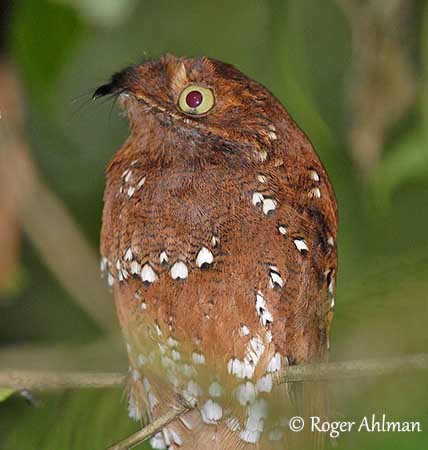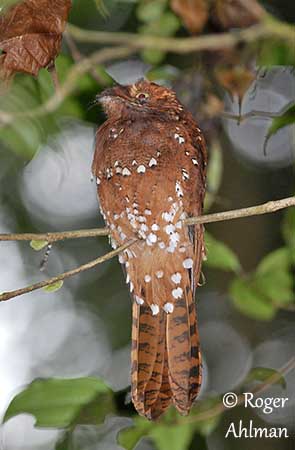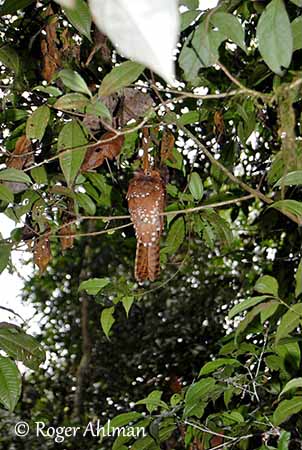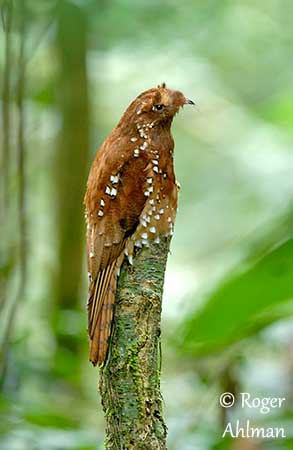
Fr: Ibijau roux
Ang: Rufous Potoo
All: Tropfentagschläfer
Esp: Nictibio Rufo
Ita: Nittibio rossiccio
Nd: Rosse Reuzennachtzwaluw
Sd: rödbrun poto
Port: Urutau-ferrugem
Photographer:
Roger Ahlman
Pbase Galleries Peru and Ecuador
Text by Nicole Bouglouan
Sources:
HANDBOOK OF THE BIRDS OF THE WORLD Vol 5 by Josep del Hoyo-Andrew Elliott-Jordi Sargatal - Lynx Edicions - ISBN: 8487334253
NIGHTJARS - A Guide to Nightjars and Related Nightbirds – Nigel Cleere and Dave Nurney - Yale University Press - First Edition (August 11, 1998) - ISBN 10: 0300074573 / ISBN 13: 9780300074574
A GUIDE TO THE BIRDS OF COLOMBIA by Steven L. Hilty and William L. Brown - Princeton University Press – ISBN 069108372X
BirdLife International (BirdLife International)
Neotropical Birds – Cornell Lab of Ornithology
Wikipedia, the free encyclopaedia
Field Guides - Bird Buzz: Rufous Potoo by Bret Whitney
Alejandro Solano-Ugalde Boletín SAO Vol. 20
Natural history of Rufous Potoo in Ecuador
Rufous Potoo
Nyctibius bracteatus
Caprimulgiformes Order – Nyctibiidae Family
INTRODUCTION:
The Rufous Potoo is the smallest species of the family Nyctibiidae. Its resemblance to a dead leaf makes it very difficult to spot while it is roosting in tree. It frequents forest interiors where the reddish tones of its plumage blend with the colour of the dead leaves. It is restricted to the primary forest in lowland Amazonia.
This species differs from other potoos by plumage and vocalizations, but the information is scarce and the behaviour is poorly known.
DESCRIPTION OF THE BIRD:
Biometrics:
Length: 21-25 cm
Weight: 46-58 g
The Rufous Potoo adult has cinnamon-rufous to deep orange-rufous plumage overall. The upperparts are finely barred and spotted blackish, especially on the head. The wing-coverts show dark brown speckles and the scapulars are spotted white. The white spots are black-encircled on shoulders and tertials. The tail is faintly barred blackish-brown.
The underparts show similar colour with conspicuous white spotting. The large white spots are narrowly edged black on upper belly. Throat, undertail-coverts and undertail appear paler.
On the head, we can see long bristles on the loral area.
The short curved bill is black. The eyes are yellow but may appear white sometimes, with a dark marking in the lowest part similar to a black keyhole. Legs and feet are brownish.

Male and female are similar.
The juvenile has cinnamon upperparts finely vermiculated brown with sparse rufous feathers. Crown, nape, back and wing-coverts are spotted blackish. The underparts are similar but with pale, greyish-white throat. The eyes are pale yellow.
The immature is duller and browner and lacks the white spots.
RANGE:
The Rufous Potoo occurs in some scattered areas in Venezuela, E Ecuador and E Peru, to N Brazil and the Guianas. It probably occurs in Amazonian lowlands too.
HABITAT:
The Rufous Potoo frequents primary and developed secondary lowland terra firme (never flooded) rainforest where it occurs both in understorey and mid-level. It can be found too in swampy palm forest, but it favours forest interiors of evergreen rainforests. This species is visible up to 550 metres of elevation in W Amazonia.
It often perches in trees, but sometimes within one metre above the ground.
CALLS AND SONGS: SOUNDS BY XENO-CANTO
The Rufous Potoo’s call is a single note “wup” or “urt” sometimes rapidly repeated.
The song is a lamenting wail, a descending, sometimes quavering “boobooboobooboo”. It sings from perches, often horizontal branches, about 7 metres above the ground.
The Rufous Potoo is vocal mainly at night from dusk to dawn, and especially around the full moon.

BEHAVIOUR IN THE WILD:
The Rufous Potoo feeds on flying insects of various species including Coleopteran, Orthopteran, Lepidopteran, Hymenopteran and Neuropteran, caught by short sallies from perch. This technique involves acrobatic flycatching manoeuvres from some centimetres to several metres of distance. Then, the bird returns to the same perch, often changing suddenly the direction.
The different foraging attempts can be performed higher, at the same height or lower than the perch. During the foraging behaviour, the bird gives only a single “wup” note, or series of 8-10 notes. The Rufous Potoo forages and feeds at dusk and by night.
Unlike other potoos that remain hidden and protected by their cryptic, bark-like plumage, the Rufous Potoo cannot mimic a dead tree with its rufous plumage. However, it is very similar to dead leaves in vine tangles or thick trees.
From an observation, several dead leaves develop holes and white fungus, very similar to the large white spots scattered on the plumage of the bird. While remaining motionless at day-time roost, the Rufous Potoo blends perfectly with the leaves of reddish Cecropia subspecies.
Another behaviour shows the perched bird moving its body in a rocking motion like a leaf moving with the wind. This behaviour is fairly similar to that of some Ardeidae species of genus Botaurus which follow the reeds moved by the wind to remain invisible.
During the roosting time, the Rufous Potoo closes its eyes, but it can see perfectly through a narrow slit between the two eyelids.

The Rufous Potoo is monogamous and both parents share all the nesting duties. The pair-bond is probably long. They do not build a nest and use a natural depression atop of broken stub or similar site.
This species is probably sedentary.
The flight is silent. The bird beats its wings stiffly and buoyantly, like a huge butterfly.
REPRODUCTION OF THIS SPECIES:
The breeding season occurs in middle to late dry season, approximately between September and February.
The Rufous Potoo does not build a nest. The eggs are laid in a slight depression at top of vertical tree-stump, or in a snag on a tree-trunk, or at the bend of a sloping branch, usually between 2 and 2, 50 metres above the ground.
The female lays a single blotched egg. Both adults incubate during about one month. The chick is fed by regurgitation mainly just after dusk and before dawn. It fledges about two months after hatching.
The chick is brooded by one parent. The adult sits at its back as the chick is facing forwards from beneath the feathers of the adult’s belly.

PROTECTION / THREATS / STATUS:
The Rufous Potoo is rare and local throughout the range. The species is not really threatened as long as extensive areas of forest remain intact, but it is suspected to lose 11-13% of suitable habitat by deforestation.
The population is suspected to decline by 25% over three generations. But currently, the Rufous Potoo is evaluated as Least Concern.